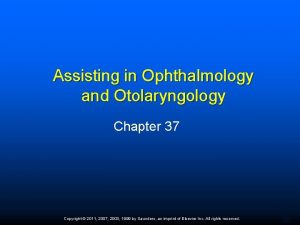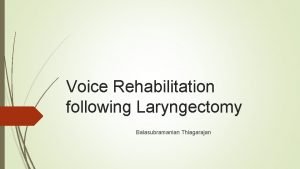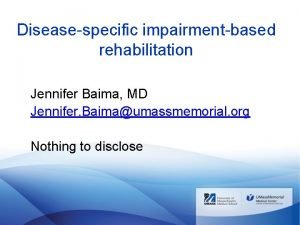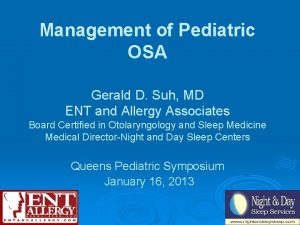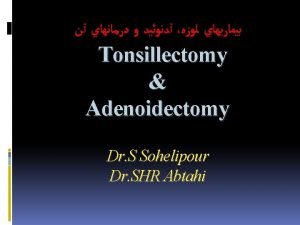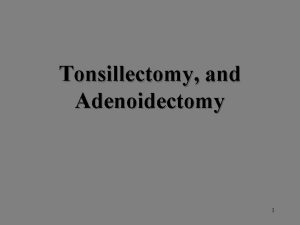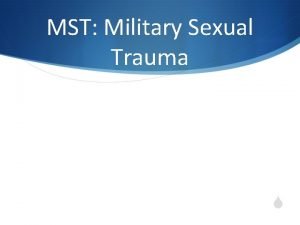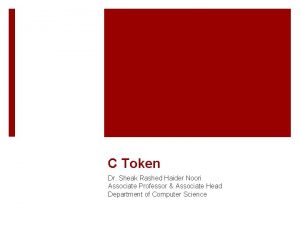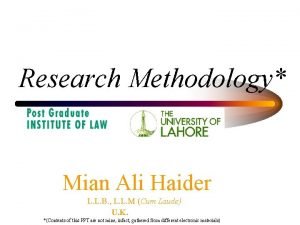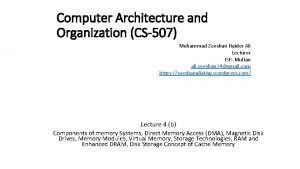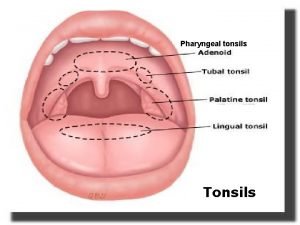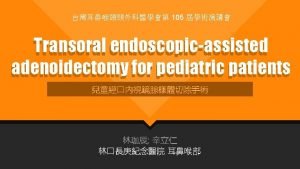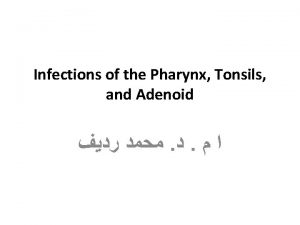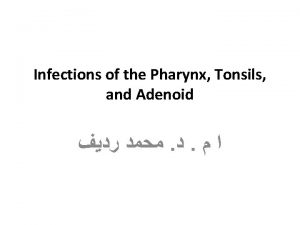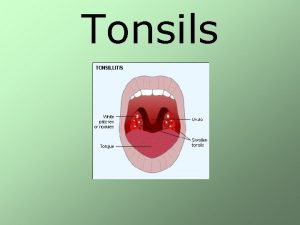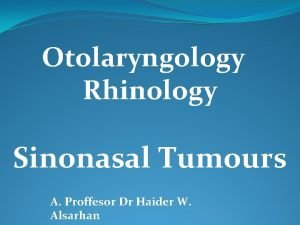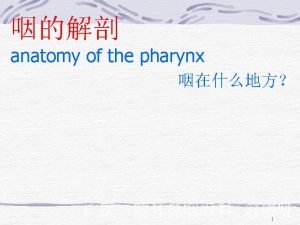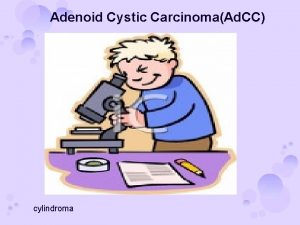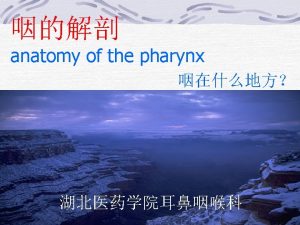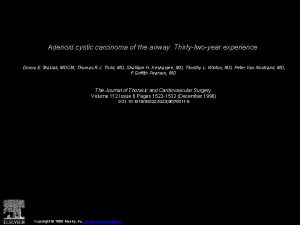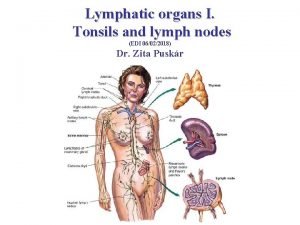Otolaryngology The Tonsils and the Adenoid Dr Haider















- Slides: 15

Otolaryngology The Tonsils and the Adenoid Dr Haider Alsarhan

Tonsils The tonsils are paired secondary lymphatic organs situated on the side of the oropharynx between the palatoglossal and the palatopharyngeal folds

Aetiology of acute tonsillitis viruses (e. g. influenza, paraininfluenza, adenovirus, enteroviruses and rhinoviruses) bacteria (B heamolytic streptococcus, Streptococcus pneumonias, Haemophihis influemaeasae anaerobic organisms).

Clinical features General pyrexia, malaise and headache Specific sore throat. Pain may radiate to the ears or may occur in the neck due to cervical lymphadenopathy. Swallowing maybe painful (odynophagia) and the patient's voice may sound muffled

Management Penicillin V is still the drug of choice, with erythromycin reserved for those patients allergic to penicillin. Ampicillin should never be used to treat acute tonsillitis in case the patient has infectious mononucleosis, when a generalized maculopapular rash may develop. The patient should have paracetamol for analgesia. Aspirin is contraindicated in children because of the risk of Reye's syndrome

Complications of acute tonsillitis 1. Local. • Severe swelling causing respiratory obstruction. • Abscess formation: Peritonsillar (quinsy). Parapharyngeal. Retropharyngeal. • Acute otitis media. • Recurrent acute tonsillitis (chronic tonsillitis). 2. General. • Septicaemia. • Meningitis. • Acute rheumatic fever. • Acute glomerulonephritis � � � �

Tonsillectomy Indications for tonsillectomy � • Recurrent episodes of acute tonsillitis. � • Previous episodes of peritonsillar abscess (quinsy). � • Suspected neoplasm (unilateral enlargement or ulceration) � • Part of another procedure (UVPP, access to glossopharyngeal nerve or styloid Process). � • Gross enlargement causing airway obstruction (sleep apnoea syndrome).

Tonsillectomy Contraindications • Recent episode of tonsillitis or upper respiratory tract infection (within 2 weeks). • Bleeding disorder. • Oral contraceptives. • Cleft-palate. • During certain epidemics (e. g. polio).

Tonsillectomy Complications of tonsillectomy � 1. Peroperative. � • Anaesthetic reaction. � • Haemorrhage. � • Damage to teeth. � • Trauma to the posterior pharyngeal wall (careless insertion of the tongue blade). � • Dislocation of the temperomandibular joint by over -opening the mouth gag. � 2. Immediate. � • Reactionary haemorrhage. � • Anaesthetic complications. � �

� � � 3. Early. • Secondary haemorrhage. • Haematoma and oedema of the uvula. • Infection (may lead to secondary haemorrhage). • Earache (referred pain or acute otitis media). • Pulmonary complications (pneumonia and lung abscess are rare). • Subacute bacterial endocarditis (if the patient has a cardiac defect). • 4. Late. • ' Scarring of the soft palate (limiting mobility and possibly affecting voice). • Tonsillar remnants (which may be the site of recurrent acute infection).

THE ADENOID Pathology The relation between the size of the adenoid to the size of the nasopharynx obstruction of the Eusiachian tubes will cause OME

Clinical Feature Nasal obstruction hyponasal speech adenoid facies (an open lip posture, prominent upper incisors, a short upper lip. a thin nose and ahypoplastic maxilla with a high arched palate)

Treatment � Medical Treatment: Antibiotics and antihistamines for 3 weeks Indications for Adenoidectomy � 1. Nasal obstruction. � 2. Otitis media with effusion (glue ear). � 3. Recurrent acute otitis media. � 4. Chronic rhinosinusitis. � 5. Sleep apnea Contra-indications � Recurrent upper respiratory tract infection � Uncontrollable bleeding � Cleft palate

Complications of Adenoidectomy Immediate: • Anaesthetic complications. • Soft palate damage. • Dislocation of the cervical spine. • Reactionary haemorrhage. Early: • Secondary hemorrhage. • Subluxasion of the atlanio-occipital joint Late: • Eustachian tube stenosis. • Hypenasal speech (rhinolalia aperta). • Persistence of symptoms.

THANK YOU
 Chapter 31 ophthalmology and otolaryngology
Chapter 31 ophthalmology and otolaryngology Meditouch otolaryngology
Meditouch otolaryngology Jennifer baima
Jennifer baima Adenoid facies
Adenoid facies Diplacusis seen in
Diplacusis seen in Yahoo
Yahoo Adenoid facies
Adenoid facies Theresa haider
Theresa haider Myla haider
Myla haider Dr. sheak rashed haider noori
Dr. sheak rashed haider noori Lyrics of bibi zehra ye dua hai
Lyrics of bibi zehra ye dua hai Aisha mian cum
Aisha mian cum M zeeshan haider
M zeeshan haider Samra haider
Samra haider Va mst screening questions
Va mst screening questions House building finance company limited
House building finance company limited
